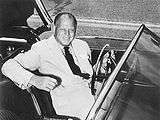 Harley Earl, "Father of the Corvette" Harley Earl, "Father of the Corvette"
"Attempting to identify a group of people who qualify as Corvette ‘legends’ is a daunting task – certainly not a chore for the faint-of-heart. No matter how hard we try, we run the very real risk of offending someone. Behind all the well-known people like Harley Earl, Ed Cole, Bill Mitchell, Zora Arkus-Duntov and Dave McLellan (to name just a few), there have been literally thousands of talented men and women who have contributed their blood, sweat and tears to Corvette’s success over its 44-year life span. They may be unsung and unrecognized, but they are bona fide "legends" in their own right. Their fingerprints are all over the car, even if their names are not, and we owe each one of them a sincere debt of gratitude."
Tom Hoxie
Director – Product
Communications
Chevrolet Motor Division
November 1996
Harley Earl was born November 22, 1893 in California. His father, J.W. Earl was a coach builder and ran the Earl Automotive Works, a custom design shop whose clients were movie stars of the 1920s.
Harley Earl began his studies at Stanford University but dropped out to study design with his father at Earl Automotive Works. By age of 30 Harley Earl was wining and dining with some of the biggest celebrities of the time. In 1927, Earl Automotive Works was sold to Cadillac's west coast distributor Don Lee and Harley Earl was hired to supervise the newly created Art and Color Section at General Motors. The Art and Color Section was the first in-house stying department in the American automotive industry.
In 1937, Earl changed the name of his Art and Color Section to the "Style Section." One of the ways Earl helped show his models and creations was by two types of design methods. One was a two dimensional rough sketch and the other was a three dimensional clay model. These clay models are still used today by almost all major automotive manufacturers. When Earl retired from GM in 1959, he left behind a legacy of stlying cues that included the use of chrome, two tone paint, tail fins, hardtops and wrap around windshields. His design talent and affection for the unusual regularly stunned the more conservative automotive traditionalists.
For those in the know, Harley Earl is generally regarded as the “Father of the Corvette.” Earl had made a name for himself at GM by setting trends in automotive style. So it was, in the early 1950s, that Earl became concerned about a growing new trend: The rising popularity of European sports cars like the Jaguar XK120, MG TD, Triumph TR2 and Austin-Healy. These cars were beginning to dominate the American enthusiast market, and GM had yet to capitalize on the opportunity.
Earl found a likely co-conspirator in Ed Cole, then Chief Engineer at Chevrolet, a division with a reputation for stodgy cars. Together, Earl and Cole developed a concept for a two-seat sports car. With help from designer Bob McLean, a plaster mock-up (internally referred to as Project Opel) was created.
Earl and Cole then sold the concept to GM’s president, Harlow Curtice, and Chevrolet’s conservative General Manager, Tom Keating, in April of 1952. It was displayed as the Chevrolet Corvette “Dream Car” at the January 1953 GM Motorama in New York’s Waldorf Astoria. And the rest is history.
Earl retired from GM in 1958 — just five years after the first public viewing of the Corvette. But by then, engineering legend Zora Arkus-Duntov had arrived on the scene; the Corvette was faster, handled better, and was on its way to a firm place in history, as was Harley Earl.
Bill Mitchell became Earl's successor.
References: Press Release, GM Communications, November 1996 |
